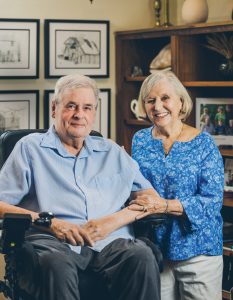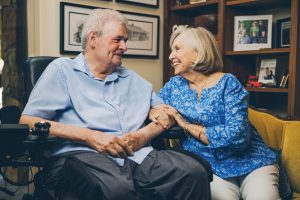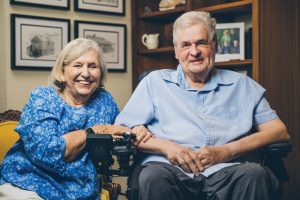A Partnership with Deep Roots
It seems like Sandy and Charles White have always been part of each other’s life. They met in fourth grade and started “going together” in eighth grade. Now married 60 years, they intend to stay together as long as they can, and Butterfield Trail Village enables them to do just that.
For the last decade, a medical condition has increasingly restricted Charles’s physical strength and mobility. The close proximity of BTV’s Health Care Center to residential apartments facilitates essential daily care for Charles, while allowing him to easily drive his Permobil power wheelchair and spend most of his day in the couple’s first-floor south apartment.
Sandy’s parents, Clarence and Dorothy Young, lived at BTV for many years, so she and Charles have gotten to know and deeply appreciate a number of the staff. Sandy also had a bench placed in the south courtyard in memory of her mother.
Many residents are close, life-long friends from elementary and high school days. Sandy calls the hallway outside their apartment their “street – and this neighborhood is fabulous.”
They’ve noticed how critical socialization is for people in their later years. “I have seen and believe that it’s this environment that makes people have longer lives but also very fulfilling lives,” Sandy said.
Deep Family Roots
Charles’s parents, Wayne and Ruth White, were educators and first lived in West Fork after his birth. His dad became a school administrator, moving the family to Central Arkansas and Siloam Springs before becoming superintendent of Fayetteville Public Schools from 1953-1969. Many retired teachers at BTV remember Wayne White fondly and recall him leading the way for Fayetteville to be the first major school district in Arkansas to enforce integration.
During World War II, Clarence was an Army Air Corps pilot assigned to go to the Pacific. He was able to take a short leave for Sandy’s birth, which kept him from flying gliders in Europe for D-Day, but allowed him to fly transport in the Pacific. After the war, her family moved from Little Rock to Fayetteville when she was 2 so that her dad could join his brother Paul Young’s architectural firm. The brothers left an indelible imprint on Fayetteville by designing Central United Methodist Church on Dickson Street, where the brothers were members and the Whites later wed in 1965.
Charles and Sandy both lived near City Park (now Wilson Park), where they were summer lifeguards at the pool. She was very social in school, joined the synchronized swimming team, and was on the cheerleading squad in junior high and newspaper staff in high school. Charles played football and basketball, ran track and was in band. A high achiever, he received numerous academic awards. His Boy Scout troop went to Camp Orr at the Buffalo National River in the summers.
Teens Sandy and Charles officially became an item the day Sputnik was launched: Oct. 4, 1957. A friend bet Charles she wouldn’t go to the Friday night school dance at at the UARK Theater, but she did. They’ve been together ever since.
In 1999, Charles inherited his grandfather’s farmhouse and adjacent 125 acres of hay fields and woods atop Grand Mountain in Madison County. Over the years, the couple came back for summer vacations and eventually renovated the farmhouse.
The original, two-story 1880s farmhouse had burned in 1948, but as a young boy, Charles watched his grandfather gather large rocks and harvest walnut, oak and poplar trees on site for the materials to build the current three-bedroom farmhouse. The old oak tongue and groove frame supports the home he finished with rock siding, in the “giraffe house” style then popular in the Ozarks.

A Lifelong Love for Learning, Teaching
With a full scholarship for college, Charles considered Rice University the best choice within driving distance of home. He was there when President Kennedy came to the university to announce the mission to the moon and the establishment of the Johnson Space Center. Sandy attended Cottey College in Missouri for two years on a scholarship, where she most enjoyed her philosophy and comparative religion classes and was on the synchronized swimming team.
At Rice, Charles studied experimental psychology — now called cognitive science — which focused on learning, perception, memory and thinking. He wanted to continue with graduate school and was accepted by several. He chose Stanford University for its top-rated experimental psychology department.
When Charles’s main professor from Stanford moved to New York City, so did the Whites. They lived in Brooklyn Heights, welcomed their first child, Meegan, and Charles finished his dissertation there. His research focused on eye movement and vision – researching perception, how the eyes and brain work together, and why visual illusions occur.
While most of his peers got post-doc positions, Charles got a full-time teaching job at Duke University. There, they welcomed their son, Stephen, and started their daughter in a Quaker-led school. After six years in North Carolina, they returned to New York City, where Charles taught at The New School for three years.
Their Greenwich Village apartment was near Washington Square Park, with a view of the Empire State Building. Sandy got a job as office manager at NYU’s deafness center, where she also learned American Sign Language. But with young children, they yearned to move somewhere they’d feel safer.
In 1979, Charles secured a teaching position at Concordia University in Montreal, where several colleagues were working. As part of the extensive paperwork required to immigrate into Canada, he had to get a letter from the police chief of every city he’d lived in to affirm he wasn’t a criminal, and the entire family had to be examined by the same doctor.
Charles was chair of the psychology department for several years, then became vice-dean. Sandy finished her undergraduate degree in education and then got her master’s degree in special education. She taught at a private English school for the deaf, interpreted for deaf college students, and spearheaded a new program to improve language and job skills for international deaf teens.
After 15 years in Canada, the family was ready to return to the United States. Charles found a deanship opening at the new Florida Atlantic University branch in Ft. Lauderdale. During their 19 years in Florida, Charles served as dean of liberal arts, then of science, then of both. After his sabbatical year in Fayetteville, when they oversaw the farmhouse renovations, he returned to full-time teaching. Sandy taught history, journalism and creative writing to students with special needs, using project-based learning, and was once named teacher of the year.
Facing the Unknown Together
In 2010, Charles noticed some physical weakness, with difficulty climbing stairs and getting up from chairs, and they thought it was an issue with his knees. In 2011, a specialist at Jackson Memorial Hospital in Miami diagnosed the issue as Sporadic Inclusion Body Myositis (called sIBM disease), a chronic, progressive muscle disease characterized by muscle weakness and atrophy, primarily affecting the quadriceps and finger flexors. Unlike ALS, sIBM disease only affects muscles, not the nervous system. There’s no treatment and no known cause.
Soon after the diagnosis, they attended two national conferences for patients and doctors to learn more, and they met people at different stages of the disease. As a researcher himself, Charles “was very interested in being part of the latest information and embracing what was known and what wasn’t known,” Sandy said. “It was so empowering; to get knowledge gives you power.” He later participated in a drug trial study in Houston and Kansas City, which gave them hope but didn’t produce a significant result.
As walking became more difficult, Charles used a cane for a year or so, then a walker, then a scooter. He’s been in his motorized wheelchair since 2018 and hasn’t stood up in five or six years, as his legs won’t support him. He can reposition himself in his wheelchair, tilting the angle of his posture. More recently, he’s begun losing upper body strength, and he has difficulty swallowing, a condition called dysphagia.
When Sandy’s dad was diagnosed with cancer in 2012, she and Charles moved back to Northwest Arkansas temporarily to spend more time with him and her mother. Her parents first lived in a Village Home, then in an apartment. Before her mother passed in 2017, she’d always raved about the community and care that BTV offered. In the end, Sandy and Charles knew it would be the perfect place for them to be supported with his care.
Charles and Sandy got on the Carriage Club list, then got a first-floor apartment in the spring of 2020 and started some renovations. They stayed at the farmhouse during the pandemic because Charles was immune compromised, and then officially moved to BTV in May 2022.

Finding Freedom Through Support
In their first-floor apartment, they have an exterior entrance, a patio brimming with potted plants and a garden bed populated with roses and other plants. Sandy repurposed her grandmother’s African violet stand to display a succulent garden.
Charles continues to embody a love for life and learning, even while his physical strength and control gradually fade. He reads books on his phone now that he can no longer hold a physical volume. Before he lost strength in his hands, he completed four detailed pen and ink drawings of structures at the farm: the original house, the newer one, the barn and the cellar. These hang on their living room walls, as do photos of their farm and artwork by William McNamara.
Sandy and Charles enjoy exploring the nearby paved trail, which he can easily navigate in his wheelchair. Sandy swims in the pool, joins in hikes led by Jennifer Neill, and particularly enjoys line dancing, which is good for her brain, socializing and increasing physical endurance. She also plays Canasta and Mahjong, and is part of the pen pal program with Butterfield Trail Elementary.
Charles splits his time between their apartment and the Health Care Center, which he calls his bed and breakfast. He has a room to himself, a private shower and care available 24/7. In recent months, he’s shifted to an all-liquid diet, so he goes there for meals, and Sandy usually joins him with hers.
“That’s the best thing for me, and I don’t know anywhere else we could actually do what we’re doing now. I’m in our apartment with Sandy a lot of the day, and, at night, they take care of everything I need in Health Care,” he said.
The medical care at BTV has been important to them both, and the staff have become like family over time. Sandy has been in Health Care three times, once for two months to recuperate from foot surgery. Having a therapist just down the hall also promotes a speedier, convenient recovery process.
“It’s just such a happy safety net really,” Sandy said. “And I’m not doing the heavy lifting. The things that are important are being taking care of by professionals. I can enjoy being his wife and not just his caregiver.”
Words by Michelle Parks | Photos by Stephen Ironside
